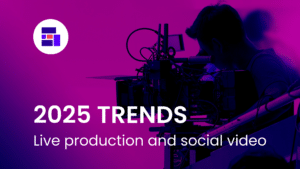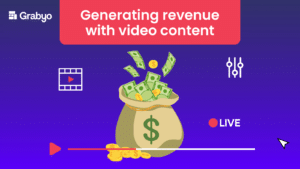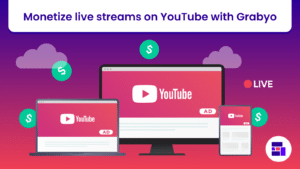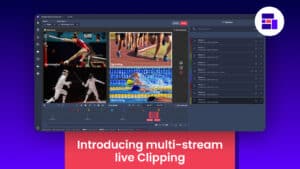Grabyo’s five broadcast and media predictions for 2022
Here are our five predictions for the media and broadcast industry for the year ahead!
1. The cloud does the heavy lifting for hybrid production
Even as social distancing measures begin to lift and production crews can get back into studios, production teams have realized the benefits of flexibility, agility, and collaboration in the cloud. Remote and hybrid production workflows are here to stay and will expand through 2022.
Cloud-based platforms address the historical shortcomings of cloud vs. on-prem production, reducing latency and adding functionality that closes the gap in output and experience.
Poll results from a recent Grabyo webinar.
2022 will be the year the cloud takes a greater share of hybrid production workflows, with more work being delivered remotely and collaboratively. The new normal will be using cloud-based tools for anything that does not need to be done on-site, such as vision mixing, graphics and distribution; allowing broadcasters to reduce the costs and environmental impact of travel, without compromising on quality.
With more of your workflow taking place in the cloud, the less you need to rely on fixed location connections, equipment upgrades, or physical production space. Cutting the cord on traditional hardware gives you the ability to innovate, and shoot/produce from anywhere. This year will see huge advancements in cloud-based broadcast technology for live production.
2. 5G will make an impact on live production workflows
5G has promised low latency and high bandwidth since it launched in 2018. It has the power to provide a flexible, remote, and multi-location production experience that rivals traditional on-premise and remote production tools.
2022 is the year that this becomes a reality for the industry, as Grabyo’s recent public preview with AWS demonstrated – a comprehensive live video production solution powered by 5G technology.
5G has a wealth of uses in the broadcast space, such as untethering camera operators and bringing new levels of flexibility to remote production. Now that it has been proven to work in public preview, expect to see more 5G adoptions in 2022.
Behind the Scenes: The World’s First Live Ad powered by 5G. We captured support from rugby fans @O2 venues across the UK via O2 5G and broadcast live on @ITV. Watch the finished ad here https://t.co/JwtVbmXZ0P. #comeonengland #ENGvNZL #WearTheRose #brandedcontent pic.twitter.com/ntweOWCOrT
— ITN Productions (@ITNProductions) October 25, 2019
3. Broadcasters tackle their carbon footprint
2021 was the year of ESG promises from the broadcast industry. Leading industry players including Netflix, YouTube, Amazon, and Sky set targets as they plan to become carbon neutral in the next ten to twenty years. All UK broadcasters also signed up to request carbon footprint details as part of the production process.
2022 will be the year of genuine change in the industry as broadcasters start to make strides in tackling the environmental impact of traditional TV production, an process which generates 9.2 tonnes of CO2 every hour.
Sky revealed that during its production of the COP26 summit, using cloud-based video production tools reduced its energy consumption from 120kw/hr to 10kw/hr, while running a cloud-based gallery consumed 5Kw/hr, compared to its traditional galleries that need 57kw/hr.*
Cloud-based solutions will be a driving force behind this new green future for the industry. Cloud production allows broadcasters to limit the use of OB trucks, reduce travel for cast and crew and significantly reduce the need to ship equipment across the world. With cloud-based tools, anyone can contribute to a broadcast from anywhere in the world. Broadcast-quality video production can be delivered in a web browser without the need to be on-site, reducing air and road travel. The shift to the cloud will be a key pillar in meeting ESG goals for the video production industry.
4. Direct to Consumer (D2C) growth slows
During the past two years, with most people stuck at home for considerable periods of time, direct to consumer services have boomed. Consumers flocked to watch the latest shows, sports, and movies on mobile and streaming platforms as they couldn’t do anything else.
At the end of 2021, as people began to return to their everyday lives, the growth in SVOD subscriptions per household flattened. Disney’s latest earning report in Q4 2021 found that the streaming service only had 2.1million net new subscribers compared to 12.1million the quarter before.
Newer services such as NBCUniversal, Warner Media, and ViacomCBS have also struggled to grow in one of the most competitive markets in the industry.
This will continue in 2022, Deloitte estimates that 150million SVOD subscribers will cancel a service this year, an increase in churn of 30%. There are many factors at play here, but the number of different services available now is a significant factor. and there is a limit on how much consumers are willing to spend on streaming when they are spending less time at home. Content options, exclusivity and availability are also crucial to continued growth, which is why investment by the streaming platforms is growing at a faster rate than the major broadcast network on a global basis.

Consolidation will further accelerate in the OTT market in 2022 as the traditional TV and satellite networks look for scale to compete with Netflix, Amazon and Apple.
This is already happening, after Disney paid $71.3billion to add to their content library earlier this year and Discovery merging with WarnerMedia.
The second stage is for leagues and sporting organizations to take control of their rights and develop their own SVOD platforms for their fans, such as LaLigaTV and NBA League Pass. With others looking to streaming platforms to accelerate growth and reach audiences beyond traditional TV – this is happening already with DAZN and Amazon Prime picking up major sports rights packages in Europe and the USA.
5. TikTok continues its rapid growth, with increasing focus on professional content
TikTok saw unprecedented growth in 2021, surpassing 1bn users with a 33% increase, making it the fastest growing social media platform of all time. In the first stage of its growth, the platform has focused on building its user base before switching its focus to monetization. However, in 2021 it made some key partnerships with leading sports and entertainment brands such as Euro 2020, showing how the platform can monetize content.
2021 was also the breakthrough year for live streaming on TikTok, popularising the live vertical video format in Music, Sports and Entertainment. user base before switching its focus to monetization. However, in 2020 it made some key partnerships with leading sports and entertainment brands such as Euro 2020, showing how the platform can monetize content.
@euro2024 Rui Patrício 🥵
♬ original sound – Europa League
With its user base and importance to pop culture in the younger generation, brands are now seeing it as a vital part of their social video strategy. In 2022 you can expect to see most of the world’s biggest brands posting to the platform and using the blueprint to deliver value engagement for sponsors set by Euro 2020, the IOC and UFC.
In reality, 2021 was already the year of TikTok, 2022; however, it is the year TikTok truly realizes its dominance in the social video mix, and brands begin to see it as their go destination.
*Source: David Travis and Kevin Mccue of Sky speaking at an AWS video production webinar, 2021.
Related blogs
Stay in touch.
Join over 10,000 media professionals and register to receive our monthly newsletter directly to your inbox!

















































